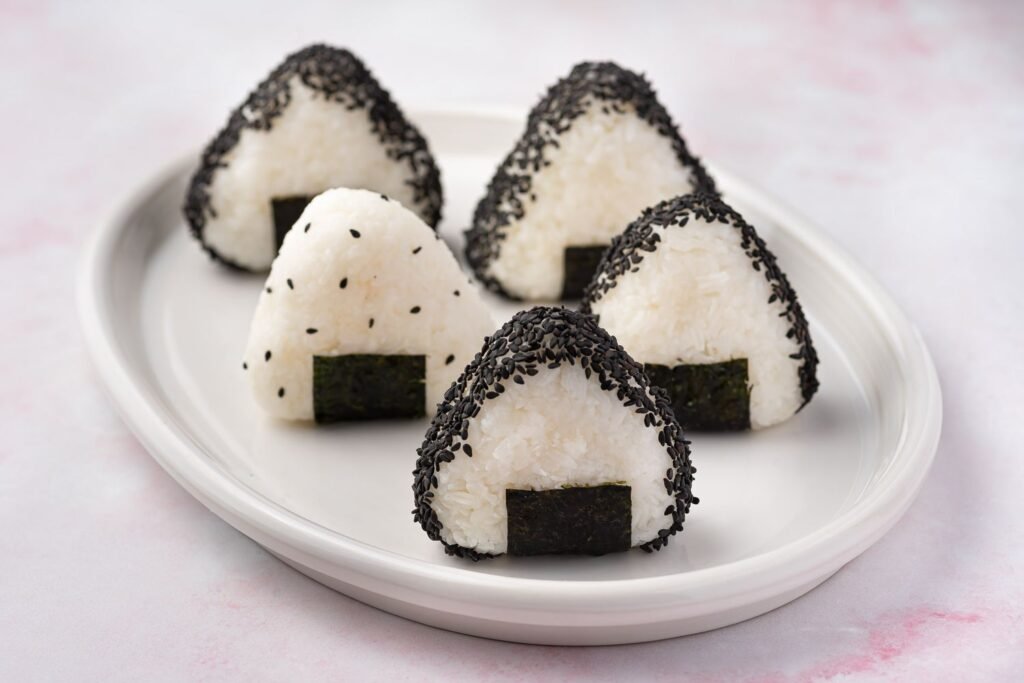I know what you’re thinking – rice balls can be made with any type of rice, right? Well, let me tell you, not all rice is created equal when it comes to creating the perfect rice ball.
In this article, I’ll be sharing with you the 10 best types of rice that will take your rice balls to the next level.
From sushi rice to jasmine rice, basmati rice to sticky rice, we’ll explore the unique qualities of each variety and how they contribute to making the most delicious and satisfying rice balls.
So, let’s get started!

Sushi Rice
Sushi rice is a popular choice for making delicious rice balls. I love using sushi rice because of its sticky texture and subtle flavor. The grains of sushi rice stick together perfectly, making it easy to shape into bite-sized balls.
When cooked, sushi rice becomes slightly sweet, adding a delightful taste to the rice balls. The combination of the sticky texture and sweet flavor makes sushi rice the ideal base for any rice ball filling. Whether I’m making traditional rice balls with pickled plum or getting creative with ingredients like spicy tuna or teriyaki chicken, sushi rice always complements the flavors beautifully.
It’s no wonder sushi rice is a go-to choice for rice ball enthusiasts like myself.
Jasmine Rice
If you’re craving a fragrant and flavorful rice option for your rice balls, try using jasmine rice.
I personally love using jasmine rice for my rice balls because of its delicate aroma and slightly sweet taste. It adds a unique and exotic twist to the traditional rice ball recipe.
To make the perfect jasmine rice balls, cook the rice according to package instructions and let it cool slightly. Then, moisten your hands with water and shape the rice into small balls.
You can either enjoy them plain or fill them with your favorite ingredients like tuna, salmon, or pickled vegetables. The combination of the fragrant jasmine rice and the tasty fillings creates a mouthwatering and satisfying snack.
Give it a try and you won’t be disappointed!
Basmati Rice
When you’re looking for a fragrant and aromatic rice option, basmati rice is a great choice. It’s one of my personal favorites when it comes to rice because of its unique flavor and long, slender grains.
The aroma of basmati rice is simply irresistible and adds a wonderful dimension to any dish. Whether you’re making biryani, pilaf, or simply enjoying it as a side dish, basmati rice elevates the overall taste and experience.
Not only does it have a delightful fragrance, but it also has a distinct nutty flavor that is truly satisfying. The grains cook up light and fluffy, making each bite a delight.
If you’re looking to add some excitement to your meals, give basmati rice a try. You won’t be disappointed.
Arborio Rice
Arborio rice is popular in risotto dishes due to its creamy texture and ability to absorb flavors.
I love using Arborio rice when I make risotto at home because it creates such a rich and velvety dish. The grains of Arborio rice are short and plump, which helps them release starch as they cook, giving the risotto its signature creaminess.
The high starch content also allows the rice to absorb all the delicious flavors of the broth, butter, and other ingredients in the risotto. This makes every bite burst with flavor.
Arborio rice is also forgiving to cook with, as it maintains its shape and texture even if slightly overcooked.
It’s no wonder why Arborio rice is a staple in Italian cuisine and a favorite among risotto lovers like me.
Sticky Rice
To achieve the desired stickiness, you should soak sticky rice before cooking it.
I love using sticky rice for my favorite dishes like sushi and rice balls. The process of soaking the rice allows it to absorb water, making it stickier and easier to mold into shapes.
I usually soak the rice for about 2 hours, but you can soak it overnight for even better results. Once the rice is soaked, I drain the water and transfer it to a steamer. Steaming the rice helps to further enhance its stickiness and gives it a soft, chewy texture.
After steaming, I let it cool slightly before using it to make delicious rice balls. Soaking sticky rice is a crucial step in creating the perfect texture and stickiness for your favorite rice dishes.
Calrose Rice
Now that we’ve talked about sticky rice, let’s move on to another type of rice that is perfect for making rice balls: Calrose rice.
I personally love using Calrose rice because of its medium grain and sticky texture. It holds its shape well when molded into balls, making it ideal for this popular Japanese snack. The grains are slightly shorter and plumper compared to other types of rice, giving the rice balls a soft and chewy consistency.
Calrose rice also absorbs flavors really well, so you can easily season it with soy sauce, furikake, or any other toppings you prefer. Whether you’re making onigiri or arancini, Calrose rice is a fantastic choice that will make your rice balls irresistibly delicious.
Brown Rice
Brown rice is a healthier alternative to white rice because it retains the bran and germ layers that contain valuable nutrients. I prefer brown rice over white rice because it is less processed and contains more fiber, vitamins, and minerals.
When I cook brown rice, it has a slightly nutty flavor and a chewy texture that I find satisfying. Plus, brown rice has a lower glycemic index compared to white rice, which means it doesn’t cause a rapid spike in blood sugar levels. This makes it a good choice for people with diabetes or those trying to manage their weight.
Overall, brown rice is a nutritious and delicious option that I enjoy incorporating into my meals.
Black Rice
You might be surprised to know that black rice, also known as forbidden rice, is packed with antioxidants and has a rich, nutty flavor that you’ll love.
I first tried black rice a few years ago, and it quickly became one of my favorite types of rice to cook with. Not only does it add a beautiful pop of color to any dish, but it also provides a range of health benefits.
The deep purple color of black rice is a result of its high antioxidant content, which helps protect our cells from damage caused by harmful free radicals. Additionally, black rice is a good source of fiber and contains essential minerals like iron and magnesium.
It’s not only delicious but also nutritious, making it a versatile and healthy choice for any meal.
Wild Rice
If you’re looking for a nutritious and flavorful alternative to regular white rice, wild rice is a great option. I love using wild rice in my meals because it adds a unique texture and nutty flavor.
Unlike white rice, which is highly processed and stripped of its nutrients, wild rice is a whole grain that is packed with fiber, protein, and essential minerals. It also has a lower glycemic index, which means it won’t cause a spike in blood sugar levels.
When cooked, wild rice has a chewy texture and a rich, earthy taste that pairs well with a variety of dishes. Whether I’m making a stir-fry or a salad, adding wild rice takes my meal to the next level in terms of taste and nutrition.
Red Rice
After exploring the unique flavor and texture of wild rice, I am excited to delve into the next type of rice for rice balls: red rice.
Red rice, with its deep reddish-brown color and nutty taste, adds a delightful twist to traditional rice balls. I love how this rice variety maintains its firmness even after cooking, making it a perfect choice for those who prefer a chewier texture.
The rich, earthy notes of red rice complement a wide range of fillings, from savory to sweet. Whether paired with vegetables, meat, or even fruits, red rice brings a beautiful pop of color and adds depth to every bite.
Don’t overlook this vibrant rice option when crafting your next batch of delicious rice balls.
Jenny has always been passionate about cooking, and she uses her platform to share her joy of food with others. Her recipes are easy to follow, and she loves giving tips and tricks to help others create their own unique culinary creations.

